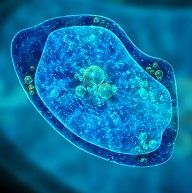Article
Brain-Eating Amoeba Cause for Alarm
Author(s):
Three types of amoebae that live in fresh water can migrate from the nose to the brain causing Primary Amoebic Meningioencephalitis, the AMA warns. With fast treatment it can be cured, otherwise it is fatal.

Brain-eating amoebic meningioencephalitis may not be as rare a disease as thought, delegates at the American Medical Association’s annual meeting in Chicago, IL said today.
Known more formally as “primary amoebic meningioencephalitis” or PAM, the illness is caused when freshwater amoebae get into the brain through the nasal passages.
That can happen by breathing in contaminated fresh water, or tap water.
Three organisms, Naegleria fowleri, Balamuthia mandrillaris, and Acanthamoeba can cause PAM.
The AMA is considering a resolution to alert physicians nationally to be on the lookout for this disease, once thought to be incurable but now seen to respond to rapid treatment.
Effective treatment calls for early diagnosis and the US Centers for Disease Control and Prevention (CDC) has set up hotlines where physicians who suspect PAM can get rapid diagnosis.
It is caused by amoebae that live in warm fresh water and once they migrate through the nose can set up in the brain as encephalitis.
“IT looks like encephalitis but the patient will often be unsalvageable,” a delegate from the American Association of Public Health Physicians reported. “We’ve got the potential to save lives but the CDC needs to work really fast to tell people not to swim without nose clips and not to use Neti cups [devices made to clear the sinuses by deliberately inhaling water] unless they boil the water first, because the amoeba can survive public water treatment.”
One strategy under consideration nationally is making PAM a reportable disease. Though cases are still rare, the fact that they could go unrecognized and be dismissed as encephalitis of unknown origin means the disease may be far more common than recognized.
There have been recent reports of patients quickly diagnosed and treated surviving PAM, the delegates learned.
The experimental drug miltefosine has shown promise in treating PAM, according to the CDC.
Delegate Jim Caruso, MD told the delegates “I’ve made the diagnosis twice, but at autopsy—I’m a pathologist.”
About a dozen cases are reported in the US annually, which Caruso said is likely “the tip of the iceberg.”





